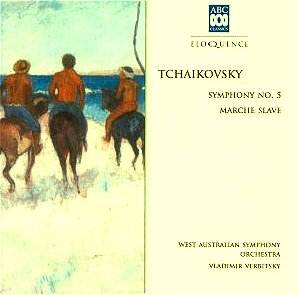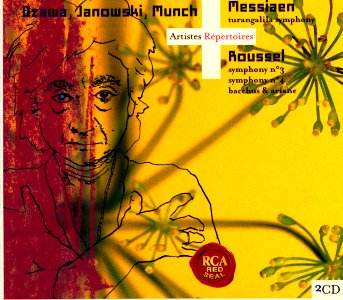 Composer: Pyotr Ilyich Tchaikovsky
Composer: Pyotr Ilyich Tchaikovsky
Works: Symphony No. 5 (1888), Marche Slave (1876)
Performers: West Australian Symphony Orchestra, Vladimir Verbitsky (conductor)
Recording: 1994, Australian Broadcasting Corporation DDD
Label: Eloquence
Tchaikovsky’s Symphony No. 5, composed in 1888, stands as a profound exploration of fate and emotional struggle, encapsulated within a richly textured orchestral palette. Emerging from the shadow of the composer’s earlier works, it encapsulates a complex emotional landscape, marked by tension and resolution that resonates deeply within the Romantic tradition. The Symphony is often characterized by its haunting motifs and expansive orchestration, which Verbitsky’s interpretation seeks to illuminate in this recording with the West Australian Symphony Orchestra.
Verbitsky adopts a lively and somewhat robust approach to the symphony, steering clear of the tempestuous extremes that might define more aggressive interpretations, such as those by Mravinsky. His reading is characterized by a warm sensitivity, particularly evident in the Andante cantabile, where the lush string tones are caressed with a careful touch, though at times it flirts with a sentimentality that some may find excessive. The conductor’s pacing in the first movement is commendable, ensuring that the thematic development unfolds organically, allowing the listener to engage with the cyclical motif that symbolizes fate. The transition to the second movement, a Valse, is executed with a buoyancy that contrasts sharply with the underlying tension of the opening, a choice that heightens the emotional stakes as the symphony progresses.
The finale is executed with a decisive gravitas, merging impetuosity with a sense of solemnity. Here, Verbitsky’s ability to build climactic excitement becomes apparent, as he balances moments of grandeur with introspective passages. The orchestration shines, particularly in the brass and percussion sections, where the weight of Tchaikovsky’s dramatic intent is vividly realized. However, one might note that the absence of visceral intensity found in more ferocious interpretations leaves a certain yearning for the raw emotional impact that can elevate this work to its zenith.
The Marche Slave, while often dismissed as a lesser work, is presented here with commendable vigor. Verbitsky’s reading benefits from a steady pulse, allowing the piece’s rhythmic drive to propel it forward, and he extracts more emotional nuance than some of his peers, such as Rozhdestvensky. Still, one cannot overlook the inherent garishness of the piece; the orchestration, though colorful, remains a somewhat superficial celebration of Slavic themes, lacking the depth found in Tchaikovsky’s more profound scores.
The engineering of this recording is commendable, capturing the orchestra’s sound with clarity and warmth. The spatial balance between sections allows for intricate details to emerge, particularly in the woodwinds, which often serve as the emotional touchstones in Tchaikovsky’s orchestration. The recording team at ABC Classics has done an admirable job in producing a sound that feels both intimate and expansive, enhancing the listener’s experience.
Verbitsky’s interpretation, while perhaps not the most dramatic or electrifying, offers a thoughtful and cohesive reading of Tchaikovsky’s Fifth Symphony. It stands as a rewarding experience for those who seek a nuanced understanding of the work, even if it occasionally falls short of the emotional peaks achieved by other renowned conductors. This recording serves as a testament to the enduring power of Tchaikovsky’s music, showcasing a commendable performance that, while not definitive, merits attention within the rich tapestry of interpretations available.



